 The Kumano
Hongu Grand Shrine is one of the Three Kumano Grand
Shrines. Branches of this shrine, called 'Kumano Jinja',
can be found all over Japan. The Kumano Hongu Shrine has
a very long history, and used to be located on a island
in the Kumano River. In 1898 it was washed away by a
major flood, after which the shrine was moved to its
present location halfway up a nearby hill. A stone path
consisting of 130 steps leads to the shrine. The new
shrine is said to be only one eighth the size of the
original shrine.
The Kumano
Hongu Grand Shrine is one of the Three Kumano Grand
Shrines. Branches of this shrine, called 'Kumano Jinja',
can be found all over Japan. The Kumano Hongu Shrine has
a very long history, and used to be located on a island
in the Kumano River. In 1898 it was washed away by a
major flood, after which the shrine was moved to its
present location halfway up a nearby hill. A stone path
consisting of 130 steps leads to the shrine. The new
shrine is said to be only one eighth the size of the
original shrine.  This shrine is
one of the Kumano Sanzan (Three Grand Shrines of Kumano).
Those who believe in the guardian spirits of this shrine
hold a strong belief in an after life, a heavenly world
where we shall go after death. It used to be the custom
that before entering the Hongu Grand Shrine one would
bathe in the healing waters of Yunomine Hot Springs
nearby. Then, in order to purify their bodies and minds,
they would enter into the Otonashi River. Hongu Grand
Shrine is said to have been built in the beginning of the
3rd century A.D.
This shrine is
one of the Kumano Sanzan (Three Grand Shrines of Kumano).
Those who believe in the guardian spirits of this shrine
hold a strong belief in an after life, a heavenly world
where we shall go after death. It used to be the custom
that before entering the Hongu Grand Shrine one would
bathe in the healing waters of Yunomine Hot Springs
nearby. Then, in order to purify their bodies and minds,
they would enter into the Otonashi River. Hongu Grand
Shrine is said to have been built in the beginning of the
3rd century A.D. to the top
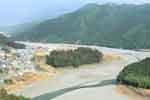 This is the original site of the Hongu Grand
Shrine. It is located on a small forested island where
the Kumano River and Otonashi River meet. The old shrine
was washed away by a flood about 100 years ago.
Moss-covered foundation stones and a stone wall still
remain and people often come to enjoy the cherry blossoms
in spring or the changing of the leaves in the autumn.
This is the original site of the Hongu Grand
Shrine. It is located on a small forested island where
the Kumano River and Otonashi River meet. The old shrine
was washed away by a flood about 100 years ago.
Moss-covered foundation stones and a stone wall still
remain and people often come to enjoy the cherry blossoms
in spring or the changing of the leaves in the autumn.  On
the 15th of April every year there is a festival in which the
participants, dressed in traditional attire, walk in procession from the
new shrine to Oyunohara.
On
the 15th of April every year there is a festival in which the
participants, dressed in traditional attire, walk in procession from the
new shrine to Oyunohara.
to the top
 This is the
head shrine for more than 3000 shrines all over Japan. It
started from the belief in the deity of Nachi Waterfall.
It has been respected as a god of Musubi (tying together
cause and effect). This god's task is to assist in
bringing about the unification of people and god. Another
meaning of the word Musubi is 'procreation'. It also
signifies the entering of the spirit into the body. The
shrine building for 12 Kumano gods used to be at the
Nachi Waterfall in ancient times until 1700 years ago
when it was moved to the present shrine building. The
main deity of the shrine is Kumanofusuminookami, also
known as, Izanaminomikoto.
This is the
head shrine for more than 3000 shrines all over Japan. It
started from the belief in the deity of Nachi Waterfall.
It has been respected as a god of Musubi (tying together
cause and effect). This god's task is to assist in
bringing about the unification of people and god. Another
meaning of the word Musubi is 'procreation'. It also
signifies the entering of the spirit into the body. The
shrine building for 12 Kumano gods used to be at the
Nachi Waterfall in ancient times until 1700 years ago
when it was moved to the present shrine building. The
main deity of the shrine is Kumanofusuminookami, also
known as, Izanaminomikoto. to the top
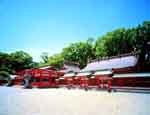 This is one
of the three Kumano Grand Shrines. The usual route for
Kumano Mode pilgrims would be to travel down the Kumano
River from Hongu to Shingu where they visited Hayatama
Shrine, then they would proceed along the coast to Nachi
Shrine located at Nachi Falls. The god of Hayatama is
believed to have first descended onto Kamikura mountain
then migrated to the present site by Kumano River. The
name Shingu (new palace) came from the fact that this was
the new place to which the god moved from Kamikura. Based
on this myth, there is a famous festival still celebrated
every February called 'Oto Matsuri' (Fire Torch
Festival). At Hayatama Shrine there is also a museum of
national treasures and a Memorial Centre for Sato Haruo
(a famous local writer).
This is one
of the three Kumano Grand Shrines. The usual route for
Kumano Mode pilgrims would be to travel down the Kumano
River from Hongu to Shingu where they visited Hayatama
Shrine, then they would proceed along the coast to Nachi
Shrine located at Nachi Falls. The god of Hayatama is
believed to have first descended onto Kamikura mountain
then migrated to the present site by Kumano River. The
name Shingu (new palace) came from the fact that this was
the new place to which the god moved from Kamikura. Based
on this myth, there is a famous festival still celebrated
every February called 'Oto Matsuri' (Fire Torch
Festival). At Hayatama Shrine there is also a museum of
national treasures and a Memorial Centre for Sato Haruo
(a famous local writer). to the top
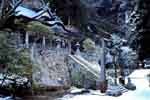
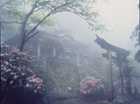 Tamaki shrine is located
near the summit of Tamaki Mountain in Totsukawa Village
in Nara Prefecture. It is unique and special in that it
is relatively untouched by the vulgarities of the modern
tourism trade. It preserves a spiritual atmosphere
reminiscent of the days when Kumano Mode was at its peak.
Tamaki shrine is located
near the summit of Tamaki Mountain in Totsukawa Village
in Nara Prefecture. It is unique and special in that it
is relatively untouched by the vulgarities of the modern
tourism trade. It preserves a spiritual atmosphere
reminiscent of the days when Kumano Mode was at its peak.
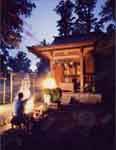
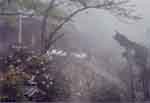 It has an
atmosphere unlike any other shrine in Kumano, surrounded
by trees, some of which are 1000-3000 years old. When
Kobodaishi (a famous monk who introduced Buddhism to
Japan in the Nara era) visited this shrine he was duly
impressed, saying, 'This is the center of 'ki' of the
world!' It is said that the shrine was built about 1800
years ago during the reign of the 10th emperor Sujin to
chase away evil spirits. Standing in front of the shrine,
in deep prayer, you will feel sure that the god of this
shrine will appear ready and able to save the world.
It has an
atmosphere unlike any other shrine in Kumano, surrounded
by trees, some of which are 1000-3000 years old. When
Kobodaishi (a famous monk who introduced Buddhism to
Japan in the Nara era) visited this shrine he was duly
impressed, saying, 'This is the center of 'ki' of the
world!' It is said that the shrine was built about 1800
years ago during the reign of the 10th emperor Sujin to
chase away evil spirits. Standing in front of the shrine,
in deep prayer, you will feel sure that the god of this
shrine will appear ready and able to save the world. to the top
 Ike Shrine in ShimoKitayama Village in Nara
Prefecture is famous as the shrine in which a powerful
'Rain God' is deified. It is also claimed that this
shrine is for a deity who resides in the 'Gracious Deity
Pond' nearby. The shrine is renovated every 21 years even
now. Its main festival falls on November 3 which is a
national holiday called Bunka no Hi ('Culture Day'). On
this day this usually quiet shrine becomes crowded with
visitors from all over.
Ike Shrine in ShimoKitayama Village in Nara
Prefecture is famous as the shrine in which a powerful
'Rain God' is deified. It is also claimed that this
shrine is for a deity who resides in the 'Gracious Deity
Pond' nearby. The shrine is renovated every 21 years even
now. Its main festival falls on November 3 which is a
national holiday called Bunka no Hi ('Culture Day'). On
this day this usually quiet shrine becomes crowded with
visitors from all over.  There are many mysterious legends regarding the
'Gracious Deity Pond' at Ike Shrine. It is not a spring,
nor does it have an inflowing or out flowing stream. Yet
the water level is said to always remain the same
regardless of external conditions. It is believed that
the deity who secretly resides in the pond controls its
flow. The pond is one of Kumano's most mysterious
locations and defies rational explanations. The legend
goes like this: Long ago, there was a giant snake living
at the foot of Kasagiyama Mountain. This snake did all
sorts of bad deeds to torment travellers and villagers
who came by. Then, one day 'En no Gyoja', one of the
founders of Mountain Buddhism, came along and
exterminated it. When he stepped on the body of the
snake, it was torn into three pieces, its head and limbs
were thrown into 'Sarusawa Pond' in Nara, Shimoichigi in
Kishu, and its torso remained here in Myojin Pond.
There are many mysterious legends regarding the
'Gracious Deity Pond' at Ike Shrine. It is not a spring,
nor does it have an inflowing or out flowing stream. Yet
the water level is said to always remain the same
regardless of external conditions. It is believed that
the deity who secretly resides in the pond controls its
flow. The pond is one of Kumano's most mysterious
locations and defies rational explanations. The legend
goes like this: Long ago, there was a giant snake living
at the foot of Kasagiyama Mountain. This snake did all
sorts of bad deeds to torment travellers and villagers
who came by. Then, one day 'En no Gyoja', one of the
founders of Mountain Buddhism, came along and
exterminated it. When he stepped on the body of the
snake, it was torn into three pieces, its head and limbs
were thrown into 'Sarusawa Pond' in Nara, Shimoichigi in
Kishu, and its torso remained here in Myojin Pond. to the top
 This small
shrine lies quietly along the river deep in the mountains
of Totsukawa. This was built for Emperor Keicho of
Nanbokucho whose life ended tragically. During the 14th
century Japan had a Northern and a Southern Emperor. In
the constant struggle for power between these two
factions Emperor Keicho of Nancho (Southern Dynasty) died
at Tennokawa (upstream of Totsukawa River), attacked by
the Northern Dynasty of the Nanbokucho Era. His body was
cast into the river, but the locals downstream searched
for him in earnest in order to give his body a proper
burial with honor. His tomb is called 'Nantei ryo' and
lies close to 'Kokuo Shrine'. We can imagine the
mortification which the locals must have felt when they
buried their own emperor after his violent and untimely
death.
This small
shrine lies quietly along the river deep in the mountains
of Totsukawa. This was built for Emperor Keicho of
Nanbokucho whose life ended tragically. During the 14th
century Japan had a Northern and a Southern Emperor. In
the constant struggle for power between these two
factions Emperor Keicho of Nancho (Southern Dynasty) died
at Tennokawa (upstream of Totsukawa River), attacked by
the Northern Dynasty of the Nanbokucho Era. His body was
cast into the river, but the locals downstream searched
for him in earnest in order to give his body a proper
burial with honor. His tomb is called 'Nantei ryo' and
lies close to 'Kokuo Shrine'. We can imagine the
mortification which the locals must have felt when they
buried their own emperor after his violent and untimely
death. to the top
 This is said to be the first place where a god
was buried in Japan. Therefore, this place has been said
to be the entrance to the other world. This supports the
idea of Kumano as a place of rebirth. It is said that in
Kumano 'you die and gain new power from the world beyond
in order to revive yourself again in this world'. Hana no
Iwaya is a power spot particularly representative of the
unique 'great rock' worship tradition found all over
Kumano. The cave at the bottom of the huge 56 metre rock
wall faces the sea and once a year becomes the centre of
a local festival. There are no shrine buildings, only a
small altar surrounded by round pebbles which gives the
place a mysterious atmosphere. Standing here you can hear
the roar of the sea from above your head as the sound of
the waves echoe against the cave.
This is said to be the first place where a god
was buried in Japan. Therefore, this place has been said
to be the entrance to the other world. This supports the
idea of Kumano as a place of rebirth. It is said that in
Kumano 'you die and gain new power from the world beyond
in order to revive yourself again in this world'. Hana no
Iwaya is a power spot particularly representative of the
unique 'great rock' worship tradition found all over
Kumano. The cave at the bottom of the huge 56 metre rock
wall faces the sea and once a year becomes the centre of
a local festival. There are no shrine buildings, only a
small altar surrounded by round pebbles which gives the
place a mysterious atmosphere. Standing here you can hear
the roar of the sea from above your head as the sound of
the waves echoe against the cave. to the top
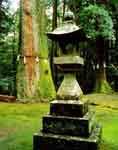 There are a couple of huge cedars which stand
like a married couple in the precincts of this shrine.
Legend has it that this is the place where Tagamaru's
body was buried after being conquered by
Sakanouenotamuramaro. A heavenly maiden which
Sakanouenotamuramaro met at Eboshi Rock (small island
near Kumano City) is said to have been a messenger of the
deity of this shrine. It seems that since ancient times
Kumano has accepted and deified defeated historical
figures like Tagamaru and Nishikitobe.
There are a couple of huge cedars which stand
like a married couple in the precincts of this shrine.
Legend has it that this is the place where Tagamaru's
body was buried after being conquered by
Sakanouenotamuramaro. A heavenly maiden which
Sakanouenotamuramaro met at Eboshi Rock (small island
near Kumano City) is said to have been a messenger of the
deity of this shrine. It seems that since ancient times
Kumano has accepted and deified defeated historical
figures like Tagamaru and Nishikitobe. to the top
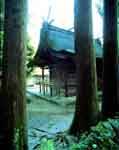 Nagisano Miya, located in Hamanomiya in
NachikatsuuraTown, once thrived as one of the Kumano
Tsukumo Oji Shrines. In ancient times the pilgrims would
bathe in the sea to purify body and mind in front of this
shrine. Even nowadays, on the night before the shrine's
annual ceremony, the young people of the area do the same
purification as did the ancient pilgrims. The Kumano Kodo
Old Road splits into two routes at Tanabe. One going by
way of Oheji along the sea, and the other by way of
Nakaheji which passes through the mountains. Both of
these paths meet again here in Hamanomiya. From here
pilgrims would travel along Nachidani valley onward to
the Nachi Grand Shrine.
Nagisano Miya, located in Hamanomiya in
NachikatsuuraTown, once thrived as one of the Kumano
Tsukumo Oji Shrines. In ancient times the pilgrims would
bathe in the sea to purify body and mind in front of this
shrine. Even nowadays, on the night before the shrine's
annual ceremony, the young people of the area do the same
purification as did the ancient pilgrims. The Kumano Kodo
Old Road splits into two routes at Tanabe. One going by
way of Oheji along the sea, and the other by way of
Nakaheji which passes through the mountains. Both of
these paths meet again here in Hamanomiya. From here
pilgrims would travel along Nachidani valley onward to
the Nachi Grand Shrine. to the top
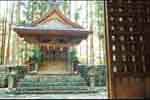 This shrine is famous for its festival which is
commonly called the 'Doburoku (unrefined sake) Festival'
near Kumano City in Mie Prefecture. This shrine has a
special rice paddy used only for growing rice for this
sake. On the day of the festival, after offerings have
been made to the gods, sake made from this paddy is then
offered to visitors and the party continues on through
the night. This festival's official name is 'Shimotsuki
(November) Festival'. As the name indicates, it is held
on November 23. They start making sake on October 15
every year. This unrefined non-transparent white sake is
made in 4 stages called 'mosutori, hatsuzoe, nakazoe, and
todome'. In the early morning of November 22, it is
prepared by a 'tonin' who has undergone a form of water
purification to prepare his mind and body for the
festival.
This shrine is famous for its festival which is
commonly called the 'Doburoku (unrefined sake) Festival'
near Kumano City in Mie Prefecture. This shrine has a
special rice paddy used only for growing rice for this
sake. On the day of the festival, after offerings have
been made to the gods, sake made from this paddy is then
offered to visitors and the party continues on through
the night. This festival's official name is 'Shimotsuki
(November) Festival'. As the name indicates, it is held
on November 23. They start making sake on October 15
every year. This unrefined non-transparent white sake is
made in 4 stages called 'mosutori, hatsuzoe, nakazoe, and
todome'. In the early morning of November 22, it is
prepared by a 'tonin' who has undergone a form of water
purification to prepare his mind and body for the
festival. to the top
 The peculiar 'Yaaya Matsuri' (Yaaya Festival) is
held under the direction of this shrine. The festival is
held every February along with the 'daimyo gyoretsu'
(feudal lord parade) and the 'dochu teodori' (dancing
parade) when the whole town is covered in decorations on
that day. A lion's mask is kept in the 'lion building' at
the shrine and is designated as a prefectural cultural
asset.
The peculiar 'Yaaya Matsuri' (Yaaya Festival) is
held under the direction of this shrine. The festival is
held every February along with the 'daimyo gyoretsu'
(feudal lord parade) and the 'dochu teodori' (dancing
parade) when the whole town is covered in decorations on
that day. A lion's mask is kept in the 'lion building' at
the shrine and is designated as a prefectural cultural
asset. to the top
 Kitayamagu Shrine is the place where the leaders
of 'Nancho' government hid themselves to try to recover
from a military setback. In the latter half of the battle
between Nancho (South Dynasty) and Hokucho (North
Dynasty), which lasted 60 years, survivors of Nancho
retreated to Kitayama Village and tried to re-gather their
forces. The villagers in Kitayama welcomed them with joy
and honored them in 'Kitayamagu' or 'Kitayama Palace'.
'Kitayamagu' remains as it was on the foot of the
mountain to tell of this story even today.
Kitayamagu Shrine is the place where the leaders
of 'Nancho' government hid themselves to try to recover
from a military setback. In the latter half of the battle
between Nancho (South Dynasty) and Hokucho (North
Dynasty), which lasted 60 years, survivors of Nancho
retreated to Kitayama Village and tried to re-gather their
forces. The villagers in Kitayama welcomed them with joy
and honored them in 'Kitayamagu' or 'Kitayama Palace'.
'Kitayamagu' remains as it was on the foot of the
mountain to tell of this story even today. to the top
 It is said that the god of Kumano first
descended on Mt. Kamikura, passed Asuka Shrine, then
settled in Hayatama Shrine. In ancient times Asuka and
Kamikura shrines were famous practice places for Mountain
Buddhist monks. In accordance with this practice the
ritual of 'Sanshamairi' (three shrine visit) of the
Otomatsuri. During that festival Noboriko, the
participants in the Otomatsuri Festival, visit Asuka
shrine, Hayatama Shrine, Myoshinji Temple before going up
to Kamikura shrine. The god in Asuka Shrine is called
Hayatamanomikoto. Within the shrine precincts lie the
shrine buildings with the rooves thatched with cypress
bark. Next to it is a model primeval house of the latter
Yayoi Era which was restored from an excavated house
within the shrine precincts and is now part of the Shingu
Historical Folklore Museum.
It is said that the god of Kumano first
descended on Mt. Kamikura, passed Asuka Shrine, then
settled in Hayatama Shrine. In ancient times Asuka and
Kamikura shrines were famous practice places for Mountain
Buddhist monks. In accordance with this practice the
ritual of 'Sanshamairi' (three shrine visit) of the
Otomatsuri. During that festival Noboriko, the
participants in the Otomatsuri Festival, visit Asuka
shrine, Hayatama Shrine, Myoshinji Temple before going up
to Kamikura shrine. The god in Asuka Shrine is called
Hayatamanomikoto. Within the shrine precincts lie the
shrine buildings with the rooves thatched with cypress
bark. Next to it is a model primeval house of the latter
Yayoi Era which was restored from an excavated house
within the shrine precincts and is now part of the Shingu
Historical Folklore Museum. to the top